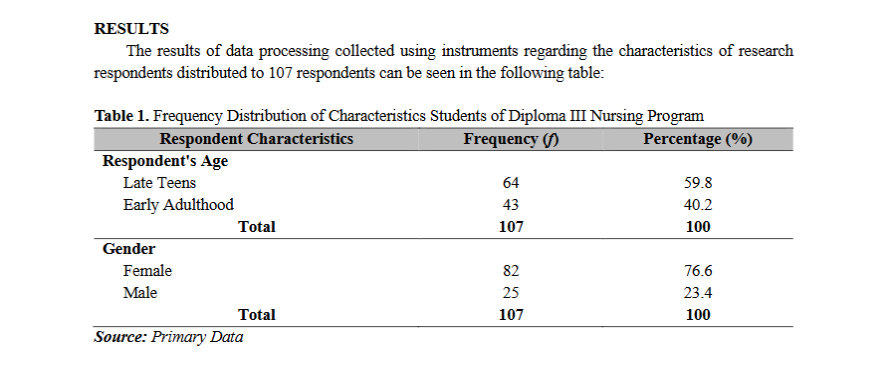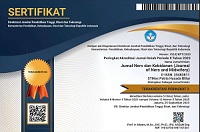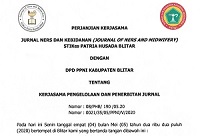Self-Efficacy Correlated with Basic Life Support Skills: Cardiopulmonary Resuscitation of Nursing Student
DOI:
https://doi.org/10.26699/jnk.v12i1.ART.p080-089Keywords:
Cardiac Arrest, Basic Life Support, Cardiopulmonary Resuscitation, Self-efficacyAbstract
Success in providing basic life support to cardiac arrest patients is influenced by self-efficacy related to readiness and confidence in giving first aid. Students as prospective health workers are required to be able to provide basic life support in emergencies. Limited training and direct experience in providing basic life support causes students' skills and self-efficacy to be less than optimal. This study aimed to identify the relationship between self-efficacy and the ability of cardiopulmonary resuscitation performed by students. A quantitative cross-sectional study was conducted on 107 diploma III nursing students selected using the proportional stratified random sampling technique. Primary data were collected using the General Self-Efficacy Scale questionnaire and basic cardiopulmonary resuscitation skills observation sheets. Hypothesis testing in the form of Spearman correlation was conducted to identify the general objectives of the study. The results of the study showed a mean value of self-efficacy of 36.06 and a mean value of basic life support skills of 89.00. The results of the Spearman test obtained a p-value of 0.0001 with a relationship strength of 0.813. It is concluded that there is a very strong positive relationship between self-efficacy and basic life support skills, which means that higher self-efficacy in performing cardiopulmonary resuscitation is directly proportional to the higher success of implementing basic life support. Researchers hope that nursing students can improve their self-efficacy related to cardiopulmonary resuscitation through regular knowledge refresher activities and basic life support skills training.
References
Ahsan, Yasin, D. D. F., & Rachmawati, S. D. (2019). Analisis faktor yang berhubungan dengan efikasi diri remaja dalam melakukan resusitasi jantung paru. Jurnal Ilmiah Kesehatan Media Husada, 8(2), 59–70. https://doi.org/10.33475/jikmh.v8i2.185
Al-Khatib, S. M., Stevenson, W. G., Ackerman, M. J., Bryant, W. J., Callans, D. J., Curtis, A. B., Deal, B. J., Dickfeld, T., Field, M. E., Fonarow, G. C., Gillis, A. M., Hlatky, M. A., Granger, C. B., Hammill, S. C., Joglar, J. A., Kay, G. N., Matlock, D. D., Myerburg, R. J., & Page, R. L. (2017). 2017 AHA/ACC/HRS Guideline for Management of Patients With Ventricular Arrhythmias and the Prevention of Sudden Cardiac Death. Heart Rhythm. https://doi.org/10.1016/j.hrthm.2017.10.036
Alaryani, Z. D., Alhofaian, A., & Elhady, M. (2021). The relationship between knoledge and self-efficacy of nurses regarding early initiation of cardiopulmonary resuscitation and automated defibrillation in Saudi Arabia. Belitung Nursing Journal, 7(5), 387–394. https://doi.org/10.33546/bnj.1670
American Heart Association. (2020). Highlight of the 2020 American Heart Association Guidelines For CPR and ECC. American Heart Association.
Bakara, D. M., Khoirini, F., & Kurniyati. (2020). Pelatihan Resusitasi Jantung Paru (Cardiac Arest) Bagi Kader Di Wilayah Kerja Puskesmas Curup Kecamatan Curup Kota Kabupaten Rejang Lebong Tahun 2019. Rambideun : Jurnal Pengabdian Kepada Masyarakat, 3(3), 41–45. https://doi.org/10.51179/pkm.v3i3.85
Chen, M., Wang, Y., Li, X., Hou, L., Wang, Y., Liu, J., & Han, F. (2017). Public Knowledge and Attitudes towards Bystander Cardiopulmonary Resuscitation in China. Biomed Research International, 1, 1–7. https://doi.org/10.1155/2017/3250485
Dwitanta, S., & Yusuf, B. (2023). Gambaran Pengetahuan, Sikap dan Praktik Mahasiswa Keperawatan terhadap Pemberian Bantuan Hidup Dasar di Poltekkes Kemenkes Palangka Raya. Jurnal Ilmiah Keperawatan Indonesia, 6(2), 141–152. https://doi.org/10.31000/jiki.v6i2.8033
Fandizal, M., Astuti, Y., Sani, D. N., Wijaya, D. S., Irsan, Safari, U., & Eviana, N. (2020). Penguatan Bantuan Hidup Dasar pada Warga RW 09 Pondok Ranggon, Cipayung, Jakarta Timur. Jurnal Pengabdian Masyarakat Kesehatan, 6(1), 13–16. https://doi.org/10.33023/jpm.v6i1.538
Fatmawati, A., Mawaddah, N., Sari, I. P., & Mujaidi. (2020). Peningkatan pengetahuan bantuan hidup dasar pada kondisi henti jantung di luar rumah sakit dan resusitasi jantung paru kepada siswa SMA. Jurnal Masyarakat Mandiri, 4(6), 1176–1184. https://doi.org/10.31764/jmm.v4i6.3048
Ferianto, K., Ahsan, A., & Rini, I. S. (2016). Analisis faktor-faktor yang mempengaruhi self efficacy perawat dalam melaksanakan resusitasi pada pasien henti jantung. Jurnal Kesehatan Mesencephalon, 2(4), 267–275. https://doi.org/10.36053/mesencephalon.v2i4.10
Handayani, A. F. (2021). Gambaran pengetahuan dan sikap mahasiswa tentang bantuan hidup dasar di Universitas Hasanuddin [Universitas Hasanudin]. http://repository.unhas.ac.id/id/eprint/6541/
Harefa, E. Y., Trimay, G., & Silitonga, E. (2023). Gambaran Efikasi Diri Mahasiswa Keperawatan Di Indonesia. Jurnal Keperawatan Cikini, 4(1), 6–14. https://doi.org/10.55644/jkc.v4i1.98
Hermanto, I., Barlianto, W., & Suryanto, S. (2021). Analysis of Factors Affecting Self-Efficacy of Fresh Nursing Graduates in Performing Cardiopulmonary Resuscitation on Cardiac Arrest Patients in Malang City, Indonesia. Jurnal Aisyah: Jurnal Ilmu Kesehatan, 6(4), 639–644. https://doi.org/10.30604/jika.v6i4.814
Hidayat, U. R., Hatmalyakin, D., Alfikrie, F., Akbar, A., Nurpratiwi, & Amaludin, M. (2022). Pelatihan Pertolongan Pertama Berbasis Model Selamat Meningkatkan Efikasi Diri Dalam Penanganan Henti Jantung di Luar Rumah Sakit. Dunia Keperawatan: Jurnal Keperawatan Dan Kesehatan, 10(2), 166–174. https://doi.org/10.20527/dk.v10i2.11
Husna, C. ‘Aisyah L., Utami, R. S., & Ropyanto, C. B. (2024). Gambaran Kesadaran, Pengetahuan, dan Sikap Mahasiswa Keperawatan terkait Bantuan Hidup Dasar. Holistic Nursing and Health Science, 7(1), 1–15. https://doi.org/10.14710/hnhs.7.1.2024.1-15
Irfani, Q. I. (2019). Bantuan Hidup Dasar. Cermin Dunia Kedokteran, 46(6), 458–461. https://doi.org/10.55175/cdk.v46i6.443
Kumalasari, S. A., Suparti, S., & Raani, K. (2021). Self-Efficacy and readiness towards early clinical exposure among nursing students. Indonesia Journal of Nursing Practices, 5(2), 104–111. https://doi.org/10.18196/ijnp.v5i1.13460
Lestari, A., & Hartati, N. (2016). Hubungan Self Efficacy dengan Subjective Well Being pada Lansia yang Tinggal di Rumahnya Sendiri. Jurnal Riset Aktual Pskologi, 7(1), 12–32. https://doi.org/10.24036/rapun.v7i1.6603
Ningsih, T. R., & Alimansur, M. (2019). The Correlation Between Self Efficacy and the Learning Achievement. Jurnal Ners Dan Kebidanan, 6(1), 63–69. https://doi.org/10.26699/jnk.v6i1.ART.p063–069
Novrianto, R., Marettih, A. K. E., & Wahyudi, H. (2019). Validitas konstruk instrumen General Self Efficacy Scale versi Indonesia. Jurnal Psikologi, 15(1), 1–9. https://doi.org/10.24014/jp.v14i2.6943
Nurfadilla, N., Tanra, A. H., & Wahab, I. (2024). Efektifitas Pemberian Bhd Terhadap Keberhasilan Henti Napas. Prepotif: Jurnal Kesehatan Masyarakat, 8(2), 2779–2792. https://doi.org/10.31004/prepotif.v8i2.28523
Palaguna, I. D. G. B. P., Ariastuti, N. L. P., & Widyanthini, D. N. (2024). Tingkat Pengetahuan Bantuan Hidup Dasar Mahasiswa Profesi Fakultas Kedokteran Universitas Udayana. Jurnal Medika Udayana, 13(4), 30–34. https://doi.org/10.24843/MU.2024.V13.i04.P06
Prayitno, H., Puspitasari, P., & Setiawan, D. R. (2020). Pengaruh pendidikan bantuan hidup dasar terhadap pengetahuan anggota unit kegiatan mahasiswa Tim Kesehatan Sarjana Keperawatan STIKes Dharma Husada Bandung. Jurnal Untuk Masyarakat Sehat (JUKMAS), 4(2), 159–171. https://doi.org/10.52643/jukmas.v4i2.1018
Purwacaraka, M., Erwansyah, R. A., & Hidayat, S. A. (2023). Pelatihan Resusitasi Jantung Paru sebagai Upaya Peningkatan Pengetahuan dan Motivasi Mahasiswa sebagai Bystander di Masyarakat. Jurnal Abdimas (Journal of Community Service): Sasambo, 5(1), 142–151. https://doi.org/10.36312/sasambo.v5i1.1109
Rahmawati, I., Pawiliyah, Fernalia, Putra, M. I. D., & Yuanda, E. (2022). Pelatihan Bantuan Hidup Dasar Berbasis Simulasi pada Mahasiswa Keperawatan. Jurnal Pengabdian Kepada Masyarakat: Mandira Cendikia, 1(1), 22–29.
Rosmawarsari, D., Yusfar, K., Faisal, I. M., & Jahirin. (2024). Pendidikan Kesehatan Dengan Media Audiovisual Terhadap Tingkat Pengetahuan Tentang Resusitasi Jantung Paru (RJP) Pada Pelajar SMK Al -Islam. Healthy Journal, 13(1), 65–74. https://doi.org/10.55222/healthyjournal.v13i1.1490
Simamora, W. R., Supriyadi, S., Fanani, E., & Marji, M. (2023). Pengaruh Video Dan Simulasi RJP Terhadap Tingkat Pengetahuan Dan Sikap Atlet Sepatu Roda Kota Malang. Jurnal Medika Nusantara, 1(4), 172–193. https://doi.org/10.59680/medika.v1i4.618
Smith, K., Andrew, E., Lijovic, M., Nehme, Z., & Bernard, S. (2015). Quality of Life and Functional Outcomes 12 Months After Out-of-Hospital Cardiac Arrest. Circulation, 131(2), 174–181.
https://doi.org/10.1161/CIRCULATIONAHA.114.011200
Suwarno, P. A. W., Sari, Z. N. G., & Waladani, B. (2019). Peningkatan Pengetahuan dan Keterampilan Bantuan Hidup Dasar Pada Relawan Bencana. Jurnal Peduli Masyarakat - Global Health Science Grup, 1(1), 13–18. https://doi.org/10.37287/jpm.v1i1.86
Syarif, H., & Mastura. (2015). Hubungan self efficacy dengan kesiapsiagaan bencana gempa bumi dan tsunami pada siswa sekolah menengah atas Negeri 2 dan 6 Banda Aceh. Idea Nursing Journal, VI(2), 53–61. https://doi.org/10.52199/inj.v6i2.6535
Utariningsih, W., Millizia, A., & Handayani, R. E. (2022). Hubungan tingkat pengetahuan Bantuan Hidup Dasar (BHD) dengan Kesiapan melakukan tindakan BHD pada mahasiswa keperawatan di perguruan tinggi kota Lhoksumawe. Jurnal Ilmiah Manusia Dan Kesehatan, 5(3), 435–444. https://doi.org/10.31850/makes.v5i3.1584
Yasin, D. D. F., Ahsan, A., & Racmawati, S. D. (2017). Analisis faktor yang berhubungan dengan efikasi diri remaja dalam melakukan resusitasi jantung paru di SMK Negeri 2 Singosari. Jurnal Ilmiah Lmu Kesehatan: Care, 5(3), 477–490. https://doi.org/10.33366/cr.v5i3.721

Downloads
Published
How to Cite
Issue
Section
License
Copyright (c) 2025 Jurnal Ners dan Kebidanan (Journal of Ners and Midwifery)

This work is licensed under a Creative Commons Attribution-ShareAlike 4.0 International License.


 Universitas Pembangunan Nasional "Veteran" Jakarta, Indonesia
Universitas Pembangunan Nasional "Veteran" Jakarta, Indonesia Google Scholar
Google Scholar Sinta
Sinta ORCID
ORCID
 Sekolah Tinggi Ilmu Kesehatan Rumah Sakit Dustira, Indonesia
Sekolah Tinggi Ilmu Kesehatan Rumah Sakit Dustira, Indonesia
 Sekolah Tinggi Ilmu Kesehatan Rumah Sakit Dustira, Indonesia
Sekolah Tinggi Ilmu Kesehatan Rumah Sakit Dustira, Indonesia



